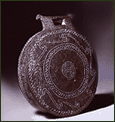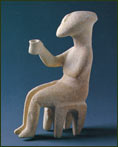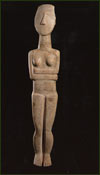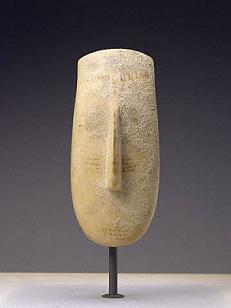Cyclades
AEGEAN: [Cyclades] [Crete] [Minoan] [Mycenaean]
See also: [Art Periods]
[Greece]
[Art History (index)]
[TIME LINE] (brought to you by Acme Time Conveyor Products)
[Cyprus] (art & language refs as well)
[Cypriot Script/Language]
On this page: {Intro}
{The Usual Suspects} (art thingies)
{Religion}
{Chronology}
Cyclades
Intro
Here is a general map of the area. Note the location of
Macedonia (where Cleopatra was born - many miss this
reference on trick questions).
This map (unfortunately tourist trades are not guided
always by the study of ancient peoples and their arts)
give a bit more info...
The so-called Cycladid Islands consist of over 25 islands
off of the South-East coast of Greece in the area where
the Mediteranian Sea (to the South and West) and the Aegean
Sea (mostly directly to the north, slightly to the east) meet.
The islands are primarily identified by things found there
and include the following islands (listed North to South) and
listed after it are key finds.
Syros - "the frying pan"
Paros
Naxos
Keros - "figure of a woman", "Seated harp player"
Melos
Thera (and the site known as Akrotiri)
Again it is important to remember the "Theran Hypothesis" that
about 1450bce an island volcano on Thera exploded. There is
ancilliary evidence from ground extracts from Ireland and
California (among others?) that the date of the explosion
could be as early as 1630-1620bce. This introduces a slew
of about 200 years into dating of *any* artifacts in the
region. The only recourse is if there are artifacts that
were traded with (eg) the Egyptian Empires of the Middle
and New Kingdoms; thus ranging from the 12th down to the
18th dynasties. In such cases, the objects *may* have some
documentation in the more accurately dated Egyptian histories.
According to The Saskatchwean Museum of Antiquities,
The sculpture produced by the artisans of the
Cyclades islands was very unique compared to
the art being produced by the Egyptians and
Mesopotamians. These sculptures, commonly
called Cycladic idols, were often used as
grave offerings, which points to the obvious
role of religion in society. All of the idols
were made of Parian marble.
-[Downloaded 2008.01.31 at 8:11 pct]-
As well the Cycladic Museum in Greece offers this:
http://www.cycladic-m.gr/
Images
The following images are well-known in Art History, and
these are primarily downloaded from the Cycladic Museum
in Greece.
(alt text is from the same site)
-[www.Cycladicl-m.gr]-
 "Clay vessel with a single handle and incised
decoration of wavy lines and circles. Such
designs on pots of this type have been thought
to allude to the sea or have celestial symnbolism.
This example, one of the best surving is almost
21 cm in diameter. White kolin (white china) has
been used to ephasise the incised pattern work.
2800-2300 BCE, Clay, Catalog # Col. No. 971."
"Clay vessel with a single handle and incised
decoration of wavy lines and circles. Such
designs on pots of this type have been thought
to allude to the sea or have celestial symnbolism.
This example, one of the best surving is almost
21 cm in diameter. White kolin (white china) has
been used to ephasise the incised pattern work.
2800-2300 BCE, Clay, Catalog # Col. No. 971."
 "Seated Figurine. The man, with elongated head and
long, relief nose (which is now chipped away) recalls
the folded-arm type of female figurines from the
same period. The statuette (15 cm high) is entirely
carved out of a single piece of marble: the daring
protrusion of the right arm, the man's entirely
separated legs and the realistic rendering of the
stool are good indications on an artist confident
in his [sic] skills. 2800-2300 BCE, White marble,
Catalog number Col. No 286."
And one of the most common found artifacts....
"Seated Figurine. The man, with elongated head and
long, relief nose (which is now chipped away) recalls
the folded-arm type of female figurines from the
same period. The statuette (15 cm high) is entirely
carved out of a single piece of marble: the daring
protrusion of the right arm, the man's entirely
separated legs and the realistic rendering of the
stool are good indications on an artist confident
in his [sic] skills. 2800-2300 BCE, White marble,
Catalog number Col. No 286."
And one of the most common found artifacts....
 "Female Figure. Stanidng at 1.40 m, this masterpiece
of Cycladic sculpture may qualify as a statue.
It follows the standard type, with the arms folded
over the abdomen and the long feet, soles slopping
downwards. It is because of the latter feature that
some scholars assume that the figurines were meant
to be reclining rather than standing."
"The only difference between this large statue and
its [sic] smaller 'sisters' is that the figures
ears are rendered in relief, as two curved crescents
along the elongated head. 2800-2300 BCE, white
marble, Catalog # Col. No. 724."
This image is similar to that as the one in Stokstad; which
she gives with a height of 63.4 cm.
The text on the museum site is interesting as well:
The majority of Cycladic Figurines show women,
nude with the arms folded over the belly. We
do not know whether they were meant to show
mortals or deities, or even whether the
Islanders venerated a number of deities, like
the later-period Greeks, or simply worshipped
one "Mother Goddess". In this case, the figurines
may have been conceived as representations of
the Goddess, or companions to her.
As Stokstad points out:
The Cyclades, especially the islands of Naxos
and Paros, had ample supplies of a fine and
durable white marble. ... These figures are
often found lying on graves.
To shape the stone, sculptors used scrapers
and chisels made from obsidain from the
island of Melos and polishing stones of
emery from Naxos. The introduction of
metal tools may have made it possible
for them to carve on a larger scale, but
perhaps because the stone fractured so
easily, they contnued to limit themselves
to simplified sculptural forms.
[Stokstad, P. 132]
REF: Stokstad, Marily (2002). Art History - 2nd Edition, Volume 1.
Harry N. Abrams, Inc, Publishers,
ISBN 0.8109.0610.4, LCCN N'5300.S923'2001
btw: the Seated Harp Player is (as of this writing 2008.02.01)
in the collection at the Metro of New York. well worth
the trip to see. The various sites have such poor renderings
of it, i'm tempted to hoist Stokstad, Vol.1 onto the scanner.
But, her book should be avail to you in your local library.
If not, pls email me.
Finally, as Suzanne Hill points out on the web site:
-[Suite101.com]-
According to the Getty Museum, much of the
modernist reverence for Cycladic figures is
“based on a misconceived aesthetic premise”
that they are abstract works of art pared
down to minimal representational forms:
flat, pure, and white. The original
appearance of the figures was much more
complex. Details like eyes, eyebrows,
hair, even garments, were brightly
painted onto the figurines and have
been worn away by time. For instance,
the figures were originally decorated
with red, black, and blue designs to
indicate facial features, jewelry,
body paint, or tattoos (some of the
details remain on this figure).
"Female Figure. Stanidng at 1.40 m, this masterpiece
of Cycladic sculpture may qualify as a statue.
It follows the standard type, with the arms folded
over the abdomen and the long feet, soles slopping
downwards. It is because of the latter feature that
some scholars assume that the figurines were meant
to be reclining rather than standing."
"The only difference between this large statue and
its [sic] smaller 'sisters' is that the figures
ears are rendered in relief, as two curved crescents
along the elongated head. 2800-2300 BCE, white
marble, Catalog # Col. No. 724."
This image is similar to that as the one in Stokstad; which
she gives with a height of 63.4 cm.
The text on the museum site is interesting as well:
The majority of Cycladic Figurines show women,
nude with the arms folded over the belly. We
do not know whether they were meant to show
mortals or deities, or even whether the
Islanders venerated a number of deities, like
the later-period Greeks, or simply worshipped
one "Mother Goddess". In this case, the figurines
may have been conceived as representations of
the Goddess, or companions to her.
As Stokstad points out:
The Cyclades, especially the islands of Naxos
and Paros, had ample supplies of a fine and
durable white marble. ... These figures are
often found lying on graves.
To shape the stone, sculptors used scrapers
and chisels made from obsidain from the
island of Melos and polishing stones of
emery from Naxos. The introduction of
metal tools may have made it possible
for them to carve on a larger scale, but
perhaps because the stone fractured so
easily, they contnued to limit themselves
to simplified sculptural forms.
[Stokstad, P. 132]
REF: Stokstad, Marily (2002). Art History - 2nd Edition, Volume 1.
Harry N. Abrams, Inc, Publishers,
ISBN 0.8109.0610.4, LCCN N'5300.S923'2001
btw: the Seated Harp Player is (as of this writing 2008.02.01)
in the collection at the Metro of New York. well worth
the trip to see. The various sites have such poor renderings
of it, i'm tempted to hoist Stokstad, Vol.1 onto the scanner.
But, her book should be avail to you in your local library.
If not, pls email me.
Finally, as Suzanne Hill points out on the web site:
-[Suite101.com]-
According to the Getty Museum, much of the
modernist reverence for Cycladic figures is
“based on a misconceived aesthetic premise”
that they are abstract works of art pared
down to minimal representational forms:
flat, pure, and white. The original
appearance of the figures was much more
complex. Details like eyes, eyebrows,
hair, even garments, were brightly
painted onto the figurines and have
been worn away by time. For instance,
the figures were originally decorated
with red, black, and blue designs to
indicate facial features, jewelry,
body paint, or tattoos (some of the
details remain on this figure).
 -[Evidence of Painted surfaces]-
Some-what splotchy patterns not un-like using
a piece of cheese cloth with some wheat-paste
and dobbing (but not tampierre) at the surface
of the face. Letting it dry and the resulting
mottled surface would be a cool rendering of
the moon's craters in low-relief.
Hmmm, pretty sketchy. Has some sort of chemical
analysis been done on the coatings?
Nota that as technologists this would be a good thinking
problem to find out something about the object in the
least intrusive manner. I would suggest either Ramann
scattering in the I/R and U/V or else atomic absorption
spectroscopy using a tunable molecular laser basing the
spectrum on possible substrates.
But, alas; i, digress.
What strikes me most directly is the like of writing. We are
told (by various sources, and certainly not by Stokstad) that
these "were a pre-literate" socieity. Probably along the same
lines that 20th century humans thought the Olmec to be aliterate
as well. However, the areas in question suffer from their direct
accessiblity and of course the numerous treasures both cultural
and minerological. Perhaps sone day we will find the Cyclaedian
equivalent of the Rosetta Stone and with the key to the Cypriotic
mystery as well. -[Cyprus]-
Regardless, as always, we must stand in awe and wonder at
the achievements of the past - ever mindful that our actions
do them justice and that life on the earth shall not perish.
-- Frank (still working on my new decimal point cloning technology ;)
--42--
-[Evidence of Painted surfaces]-
Some-what splotchy patterns not un-like using
a piece of cheese cloth with some wheat-paste
and dobbing (but not tampierre) at the surface
of the face. Letting it dry and the resulting
mottled surface would be a cool rendering of
the moon's craters in low-relief.
Hmmm, pretty sketchy. Has some sort of chemical
analysis been done on the coatings?
Nota that as technologists this would be a good thinking
problem to find out something about the object in the
least intrusive manner. I would suggest either Ramann
scattering in the I/R and U/V or else atomic absorption
spectroscopy using a tunable molecular laser basing the
spectrum on possible substrates.
But, alas; i, digress.
What strikes me most directly is the like of writing. We are
told (by various sources, and certainly not by Stokstad) that
these "were a pre-literate" socieity. Probably along the same
lines that 20th century humans thought the Olmec to be aliterate
as well. However, the areas in question suffer from their direct
accessiblity and of course the numerous treasures both cultural
and minerological. Perhaps sone day we will find the Cyclaedian
equivalent of the Rosetta Stone and with the key to the Cypriotic
mystery as well. -[Cyprus]-
Regardless, as always, we must stand in awe and wonder at
the achievements of the past - ever mindful that our actions
do them justice and that life on the earth shall not perish.
-- Frank (still working on my new decimal point cloning technology ;)
--42--
The Usual Suspects
[Back to the TOP of this page]
Religion
[Back to the TOP of this page]
Chronology
Links
google: "cycladic art"
-[Saskatchewan Museum of Antiquities]-
-[Museum of Cycladic Art in Greece]-
And special thanks to the Ministry of Travel... (for the maps!)
-[Maps of Milos, Greece]-
and
-[The Cyclades]-
-[]-
-[]-
[Back to the TOP of this page]
 "Clay vessel with a single handle and incised
decoration of wavy lines and circles. Such
designs on pots of this type have been thought
to allude to the sea or have celestial symnbolism.
This example, one of the best surving is almost
21 cm in diameter. White kolin (white china) has
been used to ephasise the incised pattern work.
2800-2300 BCE, Clay, Catalog # Col. No. 971."
"Clay vessel with a single handle and incised
decoration of wavy lines and circles. Such
designs on pots of this type have been thought
to allude to the sea or have celestial symnbolism.
This example, one of the best surving is almost
21 cm in diameter. White kolin (white china) has
been used to ephasise the incised pattern work.
2800-2300 BCE, Clay, Catalog # Col. No. 971."
 "Seated Figurine. The man, with elongated head and
long, relief nose (which is now chipped away) recalls
the folded-arm type of female figurines from the
same period. The statuette (15 cm high) is entirely
carved out of a single piece of marble: the daring
protrusion of the right arm, the man's entirely
separated legs and the realistic rendering of the
stool are good indications on an artist confident
in his [sic] skills. 2800-2300 BCE, White marble,
Catalog number Col. No 286."
And one of the most common found artifacts....
"Seated Figurine. The man, with elongated head and
long, relief nose (which is now chipped away) recalls
the folded-arm type of female figurines from the
same period. The statuette (15 cm high) is entirely
carved out of a single piece of marble: the daring
protrusion of the right arm, the man's entirely
separated legs and the realistic rendering of the
stool are good indications on an artist confident
in his [sic] skills. 2800-2300 BCE, White marble,
Catalog number Col. No 286."
And one of the most common found artifacts....
 "Female Figure. Stanidng at 1.40 m, this masterpiece
of Cycladic sculpture may qualify as a statue.
It follows the standard type, with the arms folded
over the abdomen and the long feet, soles slopping
downwards. It is because of the latter feature that
some scholars assume that the figurines were meant
to be reclining rather than standing."
"The only difference between this large statue and
its [sic] smaller 'sisters' is that the figures
ears are rendered in relief, as two curved crescents
along the elongated head. 2800-2300 BCE, white
marble, Catalog # Col. No. 724."
This image is similar to that as the one in Stokstad; which
she gives with a height of 63.4 cm.
The text on the museum site is interesting as well:
The majority of Cycladic Figurines show women,
nude with the arms folded over the belly. We
do not know whether they were meant to show
mortals or deities, or even whether the
Islanders venerated a number of deities, like
the later-period Greeks, or simply worshipped
one "Mother Goddess". In this case, the figurines
may have been conceived as representations of
the Goddess, or companions to her.
As Stokstad points out:
The Cyclades, especially the islands of Naxos
and Paros, had ample supplies of a fine and
durable white marble. ... These figures are
often found lying on graves.
To shape the stone, sculptors used scrapers
and chisels made from obsidain from the
island of Melos and polishing stones of
emery from Naxos. The introduction of
metal tools may have made it possible
for them to carve on a larger scale, but
perhaps because the stone fractured so
easily, they contnued to limit themselves
to simplified sculptural forms.
[Stokstad, P. 132]
REF: Stokstad, Marily (2002). Art History - 2nd Edition, Volume 1.
Harry N. Abrams, Inc, Publishers,
ISBN 0.8109.0610.4, LCCN N'5300.S923'2001
btw: the Seated Harp Player is (as of this writing 2008.02.01)
in the collection at the Metro of New York. well worth
the trip to see. The various sites have such poor renderings
of it, i'm tempted to hoist Stokstad, Vol.1 onto the scanner.
But, her book should be avail to you in your local library.
If not, pls email me.
Finally, as Suzanne Hill points out on the web site:
-[Suite101.com]-
According to the Getty Museum, much of the
modernist reverence for Cycladic figures is
“based on a misconceived aesthetic premise”
that they are abstract works of art pared
down to minimal representational forms:
flat, pure, and white. The original
appearance of the figures was much more
complex. Details like eyes, eyebrows,
hair, even garments, were brightly
painted onto the figurines and have
been worn away by time. For instance,
the figures were originally decorated
with red, black, and blue designs to
indicate facial features, jewelry,
body paint, or tattoos (some of the
details remain on this figure).
"Female Figure. Stanidng at 1.40 m, this masterpiece
of Cycladic sculpture may qualify as a statue.
It follows the standard type, with the arms folded
over the abdomen and the long feet, soles slopping
downwards. It is because of the latter feature that
some scholars assume that the figurines were meant
to be reclining rather than standing."
"The only difference between this large statue and
its [sic] smaller 'sisters' is that the figures
ears are rendered in relief, as two curved crescents
along the elongated head. 2800-2300 BCE, white
marble, Catalog # Col. No. 724."
This image is similar to that as the one in Stokstad; which
she gives with a height of 63.4 cm.
The text on the museum site is interesting as well:
The majority of Cycladic Figurines show women,
nude with the arms folded over the belly. We
do not know whether they were meant to show
mortals or deities, or even whether the
Islanders venerated a number of deities, like
the later-period Greeks, or simply worshipped
one "Mother Goddess". In this case, the figurines
may have been conceived as representations of
the Goddess, or companions to her.
As Stokstad points out:
The Cyclades, especially the islands of Naxos
and Paros, had ample supplies of a fine and
durable white marble. ... These figures are
often found lying on graves.
To shape the stone, sculptors used scrapers
and chisels made from obsidain from the
island of Melos and polishing stones of
emery from Naxos. The introduction of
metal tools may have made it possible
for them to carve on a larger scale, but
perhaps because the stone fractured so
easily, they contnued to limit themselves
to simplified sculptural forms.
[Stokstad, P. 132]
REF: Stokstad, Marily (2002). Art History - 2nd Edition, Volume 1.
Harry N. Abrams, Inc, Publishers,
ISBN 0.8109.0610.4, LCCN N'5300.S923'2001
btw: the Seated Harp Player is (as of this writing 2008.02.01)
in the collection at the Metro of New York. well worth
the trip to see. The various sites have such poor renderings
of it, i'm tempted to hoist Stokstad, Vol.1 onto the scanner.
But, her book should be avail to you in your local library.
If not, pls email me.
Finally, as Suzanne Hill points out on the web site:
-[Suite101.com]-
According to the Getty Museum, much of the
modernist reverence for Cycladic figures is
“based on a misconceived aesthetic premise”
that they are abstract works of art pared
down to minimal representational forms:
flat, pure, and white. The original
appearance of the figures was much more
complex. Details like eyes, eyebrows,
hair, even garments, were brightly
painted onto the figurines and have
been worn away by time. For instance,
the figures were originally decorated
with red, black, and blue designs to
indicate facial features, jewelry,
body paint, or tattoos (some of the
details remain on this figure).